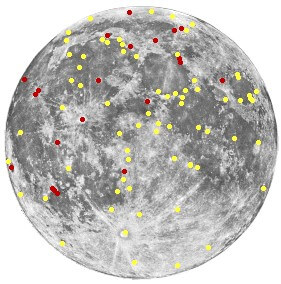
The secret of flashing lights on the moon can eventually be resolved
 08. 07. 2019
08. 07. 2019

Astronauts seen on the moon Lights since 1969, and Alan Bean Apollo 12 commented:
"I saw the lightning and I thought, did I really see the lightning?"
As it turns out, the flash is known as the Transient Lunar Phenomenon (TLP), which astronomers have documented since the end of 20. century.
As Popular Science notes:
"If you look at the Moon with a powerful enough telescope, you will notice something bizarre going on the surface. Flashes of light break out for a moment, then disappear just as quickly inexplicably. People claimed to have witnessed this for at least a thousand years, and modern astronomers have documented this phenomenon since the second half of 20. century. We see this transitional lunar phenomenon (TLP) over and over again, without any real understanding of its cause. "
TLP Incidents have even been mapped here:
But what exactly could be the cause of these flashes?
Science has been confused by this matter for years, but astronom Hakan Kayal can finally be close to answering. According to Mother Nature Network said:
"Kayal, a professor at the German University in Würzburg, has built a monthly telescope he deployed earlier this year in Spain. With a rural base north of Seville, the telescope is mostly free from the interference of light pollution, and allows its ruthless eye to remain fixed to the moon.
Build two eyes. The telescope contains dual cameras, each of which is remotely controlled from a university campus in Bavaria. When these cameras detect a flash of light, they automatically start recording images while sending an email to a German research team: And the Moon will do it again. Used in conjunction with AI software, this telescope will soon be able to record every flash of light on the Moon.
One of the main challenges for us is to further develop our event detection software with as few false alarms as possible. We already have a basic version that is functional but improvements are needed. Because the project is not yet funded by a third party and is funded only by the University, there is not too much workforce for this software. However, we have students who can improve software as part of their studies. ”
Explanation
However, Kayal already has a theory he thinks to explain the TLP phenomena on the Moon. On the moon seismic activities were also observed. When the surface moves, the gases that reflect the sunlight can escape from inside the Moon. This would explain light phenomena, some of which last for hours.
Kayal further explains:
"There were other insightful estimates of what might be responsible for flickering on the moon's surface." The most popular explanation for this phenomenon is the impact of meteorites; releasing gases or vapors, possibly through monthly shocks that may mask the surface and abnormally reflect light; electrostatic discharge due to solar wind interactions; and light emission caused by rock fracture. "
The telescope and the new software should be fully operational in about a year, and then we could finally have scientific data that tells us exactly why the moon is delighted to blink at us from a distance.





 6
6
